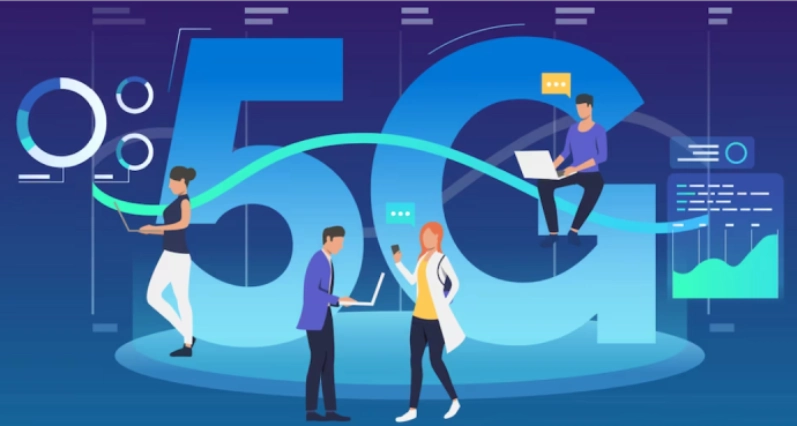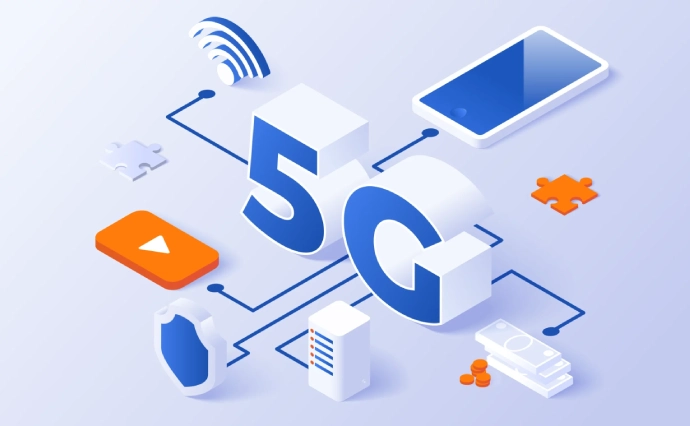What is 5G Technology:
Understanding what is 5G technology can help you grasp how it will shape our future, enhance everyday experiences, and open doors to groundbreaking opportunities. Let’s explore how this cutting-edge technology will redefine connectivity and impact our lives
In a world that’s rapidly evolving, you’ve probably heard about 5G technology, but what exactly is 5G technology, and why is it so important? This revolutionary advancement is set to transform how we connect and communicate. 5G promises to deliver faster speeds, greater reliability, and more innovative applications than ever before.
Key Differences from 4G
While 4G brought significant improvements over 3G, such as higher data rates and better coverage, 5G takes these advancements to the next level. One of the most notable differences is the increase in speed. 4G networks typically offer download speeds of up to 100 Maps, whereas 5G can achieve speeds exceeding 10 Bgs. This drastic enhancement allows for seamless streaming of high-definition videos and faster download times.
Another key difference is the reduction in latency. Latency refers to the time it takes for data to travel from the source to the destination. In 4G networks, latency is usually around 30-50 milliseconds. With 5G, latency drops to as low as 1 millisecond, enabling real-time communication and applications that demand instant response, like autonomous vehicles and remote surgery.
Furthermore, 5G supports a significantly higher number of connected devices per square kilometer compared to 4G. This is crucial for the Internet of Things (IoT) ecosystem, where billions of devices need to communicate with each other simultaneously.
The Evolution of Mobile Networks
From 1G to 5G
The journey from 1G to 5G reflects the rapid advancement in mobile technology over the past few decades. 1G, introduced in the 1980s, was the first generation of mobile networks, offering basic analog voice communication. In the early 1990s, 2G replaced it, introducing digital voice communication and text messaging capabilities..
The introduction of 3G in the early 2000s marked a significant milestone, as it provided faster data transfer rates and enabled mobile internet access. This was further enhanced by 4G, which brought high-speed data connectivity, making it possible to stream videos, play online games, and use a wide range of internet-based applications on mobile devices.

Major Milestones in Network Development
Several key milestones have shaped the evolution of mobile networks. The transition from analog to digital with 2G was a major breakthrough, allowing for more efficient use of the radio spectrum and improved call quality. The launch of 3G networks introduced mobile broadband, which paved the way for the smartphone revolution and the proliferation of mobile applications.
The advent of 4G LTE (Long-Term Evolution) brought even higher data speeds and improved network reliability, enabling services such as video conferencing, mobile TV, and cloud-based applications. Now, with the rollout of 5G, we are witnessing the dawn of a new era in connectivity, characterized by ultra-fast speeds, low latency, and the ability to support a massive number of connected devices.
How 5G Enhances Connectivity
Increased Speed and Bandwidth
One of the most significant enhancements offered by 5G technology is the dramatic increase in speed and bandwidth. Higher frequency bands achieve this by carrying more data due to their increased capacity.. As a result, 5G networks can deliver download speeds that are up to 100 times faster than those of 4G networks.
This increased speed allows for the rapid downloading and uploading of large files, seamless streaming of high-definition videos, and a smoother online gaming experience. Additionally, the enhanced bandwidth ensures that more devices can connect to the network simultaneously without experiencing congestion or slowdowns.
Low Latency Benefits
Low latency is another critical benefit of 5G technology. In a 5G network, latency can be reduced to as low as 1 millisecond, compared to the 30-50 milliseconds typical of 4G networks. This reduction is particularly important for applications that require real-time interaction.
For example, in the realm of autonomous vehicles, low latency enables the rapid exchange of data between vehicles and traffic management systems, allowing for real-time decision-making and safer driving. In healthcare, low latency facilitates remote surgeries, where a surgeon can operate on a patient from a different location with minimal delay.
Applications of 5G Technology
Impact on IoT (Internet of Things)
5G technology is set to revolutionize the Internet of Things (IoT) by providing the necessary infrastructure for billions of devices to communicate seamlessly. The enhanced connectivity and low latency of 5G networks enable a wide range of IoT applications, from smart homes and cities to industrial automation and healthcare.
In smart homes, 5G allows for the integration of various devices, such as smart thermostats, security cameras, and household appliances, to create a more efficient and convenient living environment. In industrial settings, 5G can support real-time monitoring and control of machinery, leading to increased productivity and reduced downtime.
Enhancements in Smart Cities
Smart cities stand to benefit immensely from 5G technology. The high speed and low latency of 5G networks enable the deployment of a wide range of smart city applications, such as intelligent transportation systems, smart grids, and environmental monitoring.
For instance, 5G can support the development of advanced traffic management systems that use real-time data to optimize traffic flow and reduce congestion.
Additionally, 5G-enabled smart grids can improve the efficiency and reliability of electricity distribution, while environmental sensors can provide real-time data on air quality, noise levels, and other factors, helping cities to become more sustainable and livable.
5G and the Future of Telecommunication
Innovations in Mobile Communication
5G technology is driving a wave of innovation in mobile communication. With its high-speed, low-latency capabilities, 5G is enabling the development of new applications and services that were previously not possible.
One such innovation is the concept of network slicing, which allows operators to create multiple virtual networks within a single physical 5G network. Each virtual network can be tailored to meet the specific needs of different applications, providing the necessary performance and reliability for critical services such as emergency response and autonomous driving.
The Role of 5G in Global Connectivity
5G technology is also playing a crucial role in bridging the digital divide and enhancing global connectivity. By providing high-speed internet access to remote and underserved areas, 5G can help to bring educational and economic opportunities to more people around the world.
In addition, 5G can support the development of global communication networks that connect people and devices across borders. This is particularly important for international businesses and organizations, which rely on reliable and efficient communication to operate effectively.
5G Technology in Healthcare
Remote Patient Monitoring
One of the most promising applications of 5G technology in healthcare is remote patient monitoring. With its high speed and low latency, 5G can support the real-time transmission of medical data from wearable devices and sensors to healthcare providers.
This allows doctors and nurses to monitor patients’ vital signs and health conditions remotely, providing timely and accurate diagnoses and treatments. Remote patient monitoring can be particularly beneficial for managing chronic diseases, as it enables continuous monitoring and early intervention, potentially reducing hospitalizations and improving patient outcomes.
Advanced Telemedicine Solutions
5G technology is also enabling the development of advanced telemedicine solutions. With its high-speed connectivity, 5G can support high-definition video consultations, allowing doctors to diagnose and treat patients remotely.
This can be especially valuable in rural and underserved areas, where access to healthcare services is limited. Additionally, 5G-enabled telemedicine solutions can facilitate the sharing of medical data and images between healthcare providers, improving collaboration and enabling more accurate diagnoses and treatment plans.
Impact of 5G on Entertainment and Media
Streaming Quality and Speed
The entertainment and media industries are poised to undergo significant transformations with the advent of 5G technology. One of the most immediate benefits is the enhancement in streaming quality and speed. With 5G’s ultra-fast download and upload speeds, consumers can enjoy high-definition and even 4K video content with minimal buffering.
This improved streaming capability extends to live events, where 5G can provide seamless, real-time streaming of concerts, sports events, and other live performances. The increased bandwidth also allows for more interactive and immersive experiences, such as multi-angle viewing and virtual attendance.
Virtual and Augmented Reality Experiences
5G technology is also set to revolutionize virtual and augmented reality (VR/AR) experiences. The high speed and low latency of 5G networks enable the real-time rendering of VR/AR content, creating more immersive and interactive experiences for users.
In entertainment, this means that consumers can enjoy VR concerts, virtual tours, and interactive gaming experiences with lifelike graphics and minimal lag. In media, 5G-enabled AR applications can provide enhanced storytelling and interactive content, allowing users to engage with news and information in new and exciting ways.
FAQ
Q: What is 5G technology?
5G, the fifth generation of mobile networks, delivers faster speeds, lower latency, and supports more connected devices than previous generations.
Q: How does 5G differ from 4G?
5G offers significantly higher speeds, lower latency, and the ability to connect more devices simultaneously. It uses higher frequency bands and advanced technologies like Massive MIMO and beamforming.
Q: What are the key applications of 5G?
Key applications include enhanced mobile broadband, IoT, smart cities, autonomous vehicles, remote healthcare, and advanced entertainment experiences.
Q: What are the benefits of 5G in healthcare?
5G enables remote patient monitoring, advanced telemedicine solutions, and real-time data transmission, improving access to healthcare services and patient outcomes.
How does 5G impact the entertainment industry?
5G enhances streaming quality and speed, supports VR and AR experiences, and enables more interactive and immersive entertainment options.
Q: What challenges are associated with 5G deployment?
Challenges include infrastructure requirements, security and privacy concerns, and the need for significant investment in new technologies and systems.
Q: What is the future of 5G technology?
The future of 5G includes anticipated innovations such as network slicing, edge computing, and integration with AI and blockchain. Potential upgrades include higher frequency bands and advanced antenna technologies.
